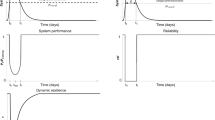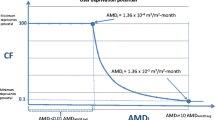Abstract
Water distribution systems (WDSs) are one of the vital infrastructures in urban areas. The common objective considered in WDSs design is providing required water with the minimum construction cost. Less attention is paid to “water quality” as an objective in optimal design of WDSs. The aim of this paper is to include a water quality based objective in WDS design alongside other common objectives. For this purpose, the water quality reliability index developed based on “chlorine residual” and “water age”, is used. EPANET2.0 is applied for WDS simulation and ACO (Ant-Colony-Optimization) has been used as the optimization algorithm. Head-Driven-Simulation-Method (HDSM) is also considered. The proposed model is applied to Jahrom (a city in the south of Iran) WDS. The outputs show that the proposed model would result in less construction costs in comparison to the original design and 4–10 % of construction cost can be reduced depending on the considered objectives and selected optimal solution by managers and decision makers while the resulted solutions include high water quality reliability (ranging from 93 to 99 %). Also using HDSM method for hydraulic analysis of WDS instead of DDSM can lead to solutions with less construction cost (U$10,000 in average) and acceptable water quality reliability.






Similar content being viewed by others
References
Afshar A, Mariño MA (2012) Multi-objective coverage-based ACO model for quality monitoring in large water networks. Water Resour Manag 26(8):2159–2176
Afshar A, Sharifi F, Jalali MR (2009) Non-dominated archiving multi-colony ant algorithm for multi-objective optimization: application to multi-purpose reservoir operation. Eng Optim 41(4):313–325
Al-Jasser AO (2007) Chlorine decay in drinking-water transmission and distribution systems: pipe service age effect. Water Res 41(2):387–396
Babaei N, Tabesh M, Nazif S (2015) Optimum Reliable operation of water distribution networks by minimizing energy cost and chlorine dosage. Water SA 41(1):149–156
Coelho ST (1996) Performance assessment in water supply and distribution. Ph.D. Thesis, Civil & Offshore Engineering Department, Heriot-Watt University, Edinburg
Dorigo M (1992) Optimization, learning and natural algorithm. Ph.D. Thesis, Politecnico di Milano, Milan
Fu G, Kapelan Z, Kasprzyk J, Reed P (2013) Optimal design of water distribution systems using many-objective visual analytics. J Water Resour Plan Manag 139(6):624–633
Ghimire S, Barkdoll B, Bergstrom P (2005) Network modeling to demonstrate efficacy of improved water quality monitoring. World Water Congress, ASCE, R Walton, Anchorage, Alaska, USA
Gupta R, Dhapade S, Bhave PR (2009) Water quality reliability analysis of water distribution networks. International Conference on Water Engineering for Sustainable Environment organized by IAHR, Vancouver, Canada, 5607–5613
Gupta R, Hussain A, Bhave PR (2012) Water quality reliability based design of water distribution networks. World Environmental and Water Resources Congress 2012, Albuquerque, 3320–3330
Islam N, Sadiq R, Rodriguez MJ (2013) Optimizing booster chlorination in water distribution networks: a water quality index approach. Environ Monit Assess 185(10):8035–8050
Kanta L, Zechman E, Brumbelow K (2012) Multiobjective evolutionary computation approach for redesigning water distribution systems to provide fire flows. J Water Resour Plan Manag 138(2):144–152
Kurek W, Ostfeld A (2013) Multi-objective optimization of water quality, pumps operation, and storage sizing of water distribution systems. J Environ Manag 115(1):189–197
Li C, Yu J Z, Zhang TQ, Mao XW, Hu YJ (2014) Multiobjective optimization of water quality and rechlorination cost in water distribution systems. Urban Water J (ahead-of-print) 1–7
Liu H, Yuan Y, Zhao M, Fang H, Zhao H (2010) Hybrid multi-objective genetic algorithm for optimal design of water supply network. Water Distribution Systems Analysis 2010, Tucson, 899–908
Mulholland M, Latifi MA, Purdon A, Buckley CA, Brouckaert CJ (2013) Multi-objective optimisation of the operation of a water distribution network. In A.K. and I.T.B.T.-C.A.C. Engineering, (ed.), 23rd European Symposium on Computer Aided Process Engineering. Lappeenranta, 709–714
Ostfeld A (2005) Optimal design and operation of multiquality networks under unsteady conditions. J Water Resour Plan Manag 131(2):116–124
Rossman LA (2000) EPANET User’s manual. Risk Reduction Engineering Laboratory, U.S. Environmental Protection Agency, Cincinnati
Shirzad A (2013) Multiobjective optimization of water distribution networks and presenting a comprehensive model for dynamic design of these networks. Ph.D. Thesis, School of Civil Engineering, College of Engineering, University of Tehran, Tehran
Shirzad A, Tabesh M, Farmani R, Mohammadi M (2013) Pressure-discharge relations with application to Head-Driven Simulation of water distribution networks. J Water Resour Plan Manag 139(6):660–670
Siew C, Tanyimboh TT, Seyoum AG (2016) Penalty-free multi-objective evolutionary approach to optimization of Anytown water distribution Network. Water Resources Management 1–18
Srinivasan S, Harrington GW, Xagoraraki I, Goel R (2008) Factors affecting bulk to total bacteria ratio in drinking water distribution systems. Water Res 42(13):3393–3404
Tabesh M, Azadi B, Roozbahani A (2011) Quality management of water distribution networks by optimizing dosage and location of chlorine injection. Int J Environ Res 5(2):321–332
Tamminen S, Ramos H, Covas D (2008) Water supply system performance for different pipe materials part I: water quality analysis. Water Resour Manag 22(11):1579–1607
Wagner JM, Shamir U, Markes DH (1988) Water distribution reliability: simulation methods. J Water Resour Plan Manag 114(3):276–294
Wang H (2013) Critical factors controlling regrowth of opportunistic pathogens in premise plumbing. PhD Thesis, Virginia Polytechnic Institute and State University, Virginia Tech, Blacksburg, US
Zabihi M (2008) Optimal design of water distribution systems considering quality constraints. M.Sc. Thesis, School of Civil Engineering, College of Engineering, University of Tehran, Tehran
Zecchin A, Simpson AR, Maeir HR, Nixon JB (2005) Parametric study for an ant algorithm applied to water distribution system optimization. IEEE Trans Evol Comput 9(2):175–191
Author information
Authors and Affiliations
Corresponding author
Electronic supplementary material
Below is the link to the electronic supplementary material.
Appendix 1
(DOCX 39 kb)
Appendix 2
(DOCX 21 kb)
Rights and permissions
About this article
Cite this article
Shokoohi, M., Tabesh, M., Nazif, S. et al. Water Quality Based Multi-objective Optimal Design of Water Distribution Systems. Water Resour Manage 31, 93–108 (2017). https://doi.org/10.1007/s11269-016-1512-6
Received:
Accepted:
Published:
Issue Date:
DOI: https://doi.org/10.1007/s11269-016-1512-6




